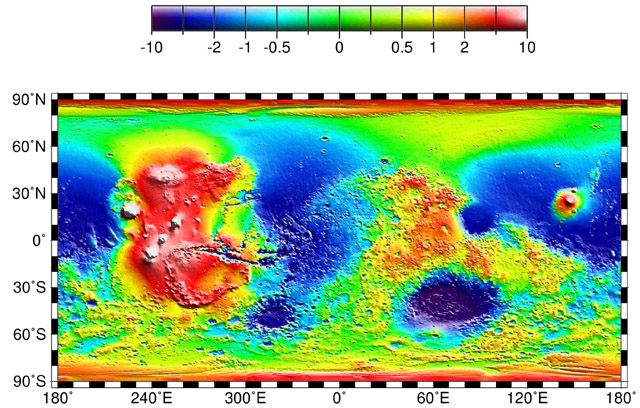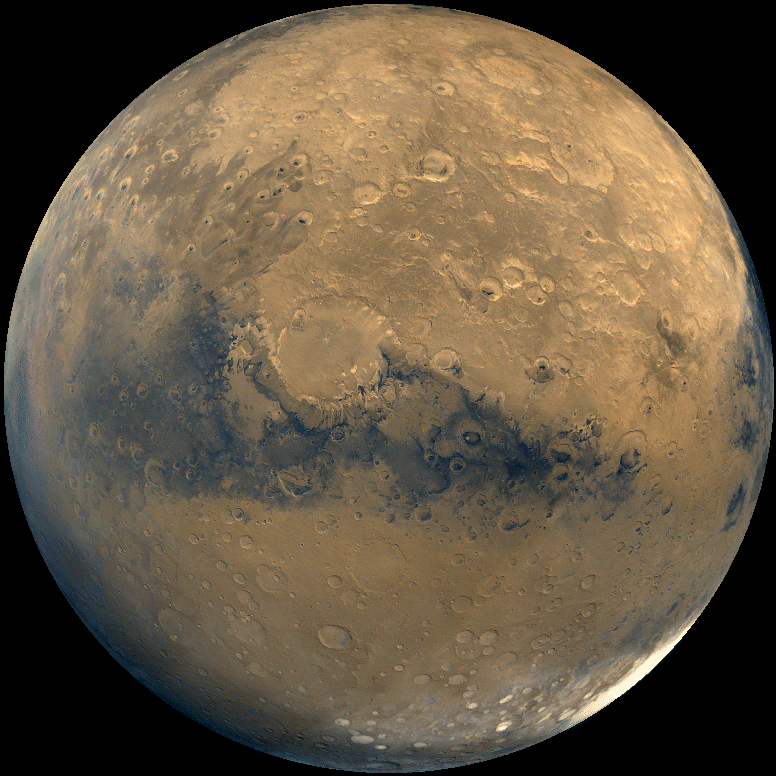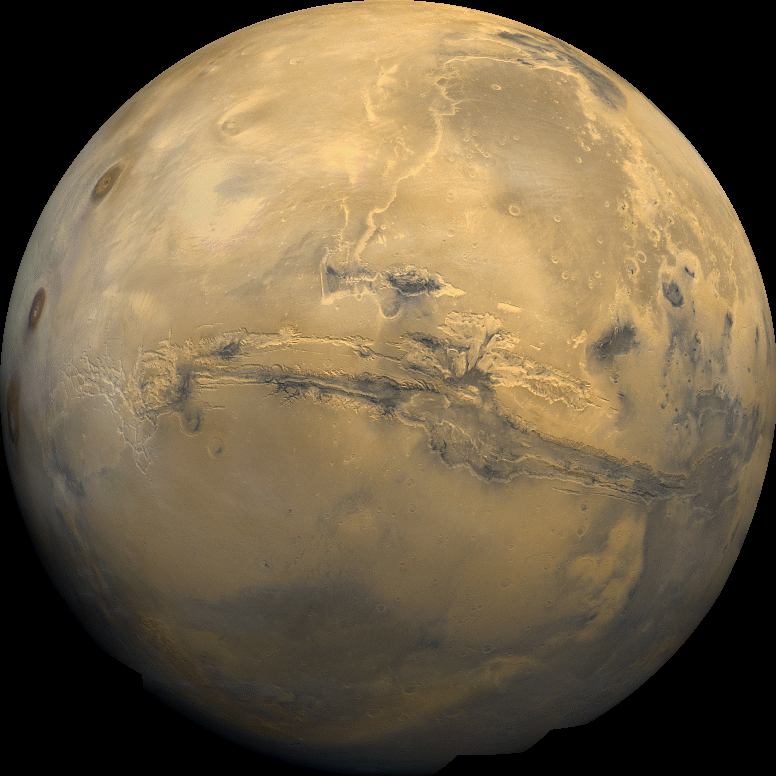
Spirit Rover panorama
When considering the surfaces of planets, one is naturally
led to consider analogues of the oceanic and continental regions of the
Earth. In this spirit, the surface of Mars can be divided up into
two types of terrain.

- Rough, cratered terrain (which superficially resemble the
lunar highlands) which covers most of the southern hemisphere
and on average, is greater than 3 km above sea level. The
cratered regions are thought to be on the order of 3.9 billion years
old.
- Plains (sites of extensive lava flows) dominate the northern
hemisphere and typically lie below sea level. On the plains
the densities of large craters are 10 - 100 times lower than in the southern
hemisphere.The plains are thought to be on the order of 3 billion years old.
The
transition between the northern and southern hemispheres can be
abrupt with elevation changes of 4 km occuring over the span of a few hundred
kilometers.
An interesting region which straddles the two zones is the
Tharsis Bulge.
- The Tharsis Bulge is roughly
the size of North America, and was volcanically active, rising to a height of
~ 10 km above sea
level.
-
The Tharsis Bulge is the least cratered and so, the youngest
part of the Mars's surface. Tharsis probably started to form
~3.9 billion years ago, but has been active until fairly recently (perhaps
as recent as several hundred million years ago). The crater density on
Tharis suggests that most features are 2-3 billion years old.
Near the top of the Tharsis Bulge, there
are three shield volcanoes, each rising 18 km
with elevtions 27 km above sea level and bases of size 400 km.
An even taller volcano (with respect to the ground),
Olympus Mons rises 25 km
above the northwestern slope of Tharsis to reach the same
height as
the Tharsis volcanoes, 27 km above sea level.
Olympus Mons
is nearly 700 km across its base, roughly the size of France and may have
been active as recently as 100-300 million years ago.
The largest Hawaiian volcano is ~200 km across its base and ~ 9 km
high (similar in elevation to Maxwell Montes on Venus).
The difference in the maximum height of volcanos on the Terrestrial
planets is a consequence of the weaker surface
gravity on Mars and lack of large scale horizontal plate motion.
Olympus Mons is the largest volcano in the Solar System.
Click for the Google Mars image of Olympus Mons.

Note that:
- The Tharsis volcanoes are shield volcanoes so
the fact that they are concentrated in one region
====> at the time the volcanos formed there
was not large scale crustal movement or, at best, only slow motion
- The slopes of the volcanos are not heavily cratered at all
(because of recent lava flows) indicating that the
volcanoes may have been active within the last few hundred million years
====> Mars was probably geologically active in recent times
(however, but not plate tectonics)
Near the Tharsis Bulge is
Valles Marineris,
part of an interconnected system of east-west running canyons
approximately 4,000 km long. The individual canyons are 3 km deep, but
in the center of the canyon, the depression is nearly 7 km and more than 500
km wide.
The Grand Canyon would fit easily into one of the tributaries of
the Valles Marineris.
These features likely started to formed around 3.5 - 3.9
billion
years ago, but based on crater densities, the last work apparently took
place around 2 billion years ago.
The Tharsis Bulge was thought to have
formed through an uplift (vertical rise) of the crust of Mars. The
Valles Marineris was also probably due to some sort of crust
cracking driven by crustal motion. It is now generally thought that the
Martian crust to the west in the Tharsis region thickened causing the
crust to crack as it cooled. The fissures were then widened by erosion.
There is ample evidence of
geological activity on Mars. There, however,
is no clear evidence of plate tectonics.
- Rough, cratered terrain (which superficially resemble the
lunar highlands) which covers most of the southern hemisphere
and on average, is greater than 3 km above sea level. The
cratered regions are thought to be on the order of 3.9 billion years
old.
- Plains (sites of extensive lava flows) dominate the northern
hemisphere and typically lie below sea level. On the plains
the densities of large craters are 10 - 100 times lower than in the southern
hemisphere.The plains are thought to be on the order of 3 billion years old.
- The Tharsis Bulge is roughly
the size of North America, and was volcanically active, rising to a height of
~ 10 km above sea
level.
- The Tharsis Bulge is the least cratered and so, the youngest part of the Mars's surface. Tharsis probably started to form ~3.9 billion years ago, but has been active until fairly recently (perhaps as recent as several hundred million years ago). The crater density on Tharis suggests that most features are 2-3 billion years old. Near the top of the Tharsis Bulge, there are three shield volcanoes, each rising 18 km with elevtions 27 km above sea level and bases of size 400 km. An even taller volcano (with respect to the ground), Olympus Mons rises 25 km above the northwestern slope of Tharsis to reach the same height as the Tharsis volcanoes, 27 km above sea level. Olympus Mons is nearly 700 km across its base, roughly the size of France and may have been active as recently as 100-300 million years ago. The largest Hawaiian volcano is ~200 km across its base and ~ 9 km high (similar in elevation to Maxwell Montes on Venus). The difference in the maximum height of volcanos on the Terrestrial planets is a consequence of the weaker surface gravity on Mars and lack of large scale horizontal plate motion. Olympus Mons is the largest volcano in the Solar System. Click for the Google Mars image of Olympus Mons.
- The Tharsis volcanoes are shield volcanoes so
the fact that they are concentrated in one region
====> at the time the volcanos formed there
was not large scale crustal movement or, at best, only slow motion
- The slopes of the volcanos are not heavily cratered at all (because of recent lava flows) indicating that the volcanoes may have been active within the last few hundred million years ====> Mars was probably geologically active in recent times (however, but not plate tectonics)
When considering the surfaces of planets, one is naturally led to consider analogues of the oceanic and continental regions of the Earth. In this spirit, the surface of Mars can be divided up into two types of terrain.
 |
|
An interesting region which straddles the two zones is the Tharsis Bulge.
|

|
Note that:
Near the Tharsis Bulge is Valles Marineris, part of an interconnected system of east-west running canyons approximately 4,000 km long. The individual canyons are 3 km deep, but in the center of the canyon, the depression is nearly 7 km and more than 500 km wide. The Grand Canyon would fit easily into one of the tributaries of the Valles Marineris. These features likely started to formed around 3.5 - 3.9 billion years ago, but based on crater densities, the last work apparently took place around 2 billion years ago.
The Tharsis Bulge was thought to have formed through an uplift (vertical rise) of the crust of Mars. The Valles Marineris was also probably due to some sort of crust cracking driven by crustal motion. It is now generally thought that the Martian crust to the west in the Tharsis region thickened causing the crust to crack as it cooled. The fissures were then widened by erosion.